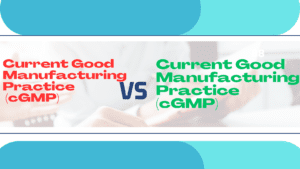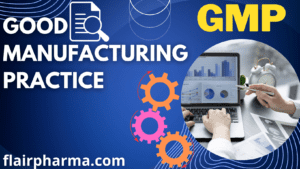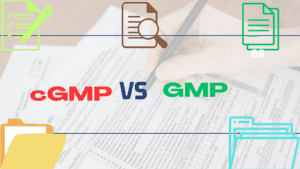In the world of pharmaceutical manufacturing, adherence to quality standards and regulatory compliance is paramount, So GMP and CGMP are the most important aspects. Two key pillars that govern this realm are Good Manufacturing Practice (GMP) and its enhanced counterpart, Current Good Manufacturing Practice (cGMP). In this article, we embark on a journey to uncover the unique characteristics and distinctions between these two crucial frameworks that shape manufacturing excellence in pharmaceutical plants.
The Foundation of GMP:

Good Manufacturing Practice (GMP) stands as a bedrock for ensuring quality and safety in pharmaceutical manufacturing. It encompasses a set of general manufacturing standards and practices that ensure products are consistently produced and controlled to meet the required quality standards. GMP guidelines serve as a global benchmark, regulated by various national and regional health authorities.
The Rise of cGMP:

While GMP lays the foundation, Current Good Manufacturing Practice (cGMP) emerges as an evolved and enhanced version of GMP, with additional regulations and requirements. Regulated by the esteemed U.S. Food and Drug Administration (FDA), cGMP specifically focuses on the manufacturing of drug products. It sets a higher standard and strives for even greater product quality, safety, and efficacy.
Documentation Precision:
One notable distinction between GMP and cGMP lies in the realm of documentation. While GMP adheres to documentation practices, cGMP raises the bar with more detailed and specific documentation requirements. Manufacturers operating under cGMP must maintain meticulous records, with a focus on precise documentation of all activities related to manufacturing, testing, and quality control.
The stringency of Compliance:
Compliance is a cornerstone of both GMP and cGMP; however, cGMP introduces a heightened level of rigor. While GMP compliance requirements may vary across different regions, cGMP compliance is strictly enforced by the FDA in the United States. Manufacturers must adhere to the specific regulations outlined by the FDA, leaving little room for interpretation.
Risk Management Emphasis:
Risk management, an essential aspect of pharmaceutical manufacturing, is considered in both GMP and cGMP. However, cGMP places a greater emphasis on risk management practices, providing clear guidelines to identify, assess, and mitigate risks associated with the manufacturing process. Manufacturers operating under cGMP must have robust risk management frameworks in place to ensure product safety and quality.
Personnel Training and Ongoing Development:
Both GMP and cGMP recognize the importance of personnel training. However, cGMP takes it a step further by emphasizing comprehensive and ongoing training programs. Manufacturers operating under cGMP must invest in the continuous development of their workforce, ensuring personnel possesses the necessary skills and knowledge to perform their roles effectively and contribute to a culture of manufacturing excellence.
Record-Keeping Precision:
Accurate record-keeping is vital in both GMP and cGMP. However, cGMP raises the bar by demanding more detailed and precise record-keeping practices. Manufacturers operating under cGMP must maintain comprehensive records of manufacturing processes, testing results, quality control measures, and more. This level of meticulousness ensures traceability and supports regulatory audits.

Difference Between cGMP and GMP
| Aspect | Good Manufacturing Practice (GMP) | Current Good Manufacturing Practice (cGMP) |
|---|---|---|
| Definition | GMP refers to general manufacturing standards and practices | cGMP is an enhanced version of GMP with added regulations |
| Regulatory Authority | Regulated by various national and regional health authorities | Regulated by the U.S. Food and Drug Administration (FDA) |
| Scope | Applies to the manufacturing of pharmaceutical products | Specifically focuses on the manufacturing of drug products |
| Documentation | Documentation practices are followed but not as strictly defined | Documentation practices are more detailed and specific |
| Compliance Requirements | Compliance is mandatory but may vary across different regions | Compliance is mandatory and strictly enforced by the FDA |
| Validation and Audits | Validation and audits are important but may have some flexibility | Validation and audits are more rigorous and standardized |
| Risk Management | Risk management is considered but may have some variations | Risk management is an integral part with clear guidelines |
| Quality Control | Quality control measures are implemented to ensure product quality | Quality control measures are more defined and stringent |
| Personnel Training | Personnel training is required but may vary in depth and frequency | Personnel training is more comprehensive and ongoing |
| Record-Keeping | Record-keeping practices are followed but may have some variations | Record-keeping practices are more detailed and precise |
Frequently Asked Questions:
What is the difference between GMP and cGMP?
Answer: GMP refers to general manufacturing standards and practices across industries, while cGMP specifically focuses on the manufacturing of drug products and is regulated by the U.S. Food and Drug Administration (FDA).
What are the regulatory authorities for GMP and cGMP?
Answer: GMP is regulated by various national and regional health authorities, while cGMP is primarily regulated by the FDA in the United States.
Are GMP and cGMP applicable to the same industries?
Answer: GMP can be applied to various industries, including food, cosmetics, and pharmaceuticals. cGMP, however, is specific to the pharmaceutical industry and drug product manufacturing.
How do documentation practices differ between GMP and cGMP?
Answer: GMP follows documentation practices, but cGMP sets more specific and detailed requirements for documentation, including record-keeping of manufacturing, testing, and quality control activities.
Do GMP and cGMP have different compliance requirements?
Answer: Compliance requirements for GMP may vary across regions, while compliance with cGMP is strictly enforced by the FDA. Manufacturers must adhere to specific cGMP regulations to ensure compliance.
How do risk management practices compare between GMP and cGMP?
Answer: While GMP considers risk management, cGMP places a greater emphasis on it. cGMP provides clear guidelines for identifying, assessing, and mitigating risks associated with the manufacturing process.
Are personnel training requirements different for GMP and cGMP?
Answer: GMP requires personnel training, but cGMP goes further by emphasizing comprehensive and ongoing training programs to ensure personnel possess the necessary skills and knowledge for drug product manufacturing.
Are validation and audits handled differently in GMP and cGMP?
Answer: GMP emphasizes validation and audits, but cGMP sets more rigorous standards for validation and requires standardized audits to ensure compliance with regulatory requirements.
How do GMP and cGMP impact product quality control?
Answer: GMP focuses on quality control measures, while cGMP establishes more specific and stringent quality control standards to ensure drug products consistently meet or exceed established quality standards.
Do GMP and cGMP have different global recognition and acceptance?
Answer: While GMP is recognized globally, cGMP specifically ensures compliance with FDA regulations and is crucial for accessing the U.S. market. Compliance with cGMP facilitates global market access for pharmaceutical manufacturers.


1 thought on “What is GMP and cGMP in the Pharmaceutical industry?”